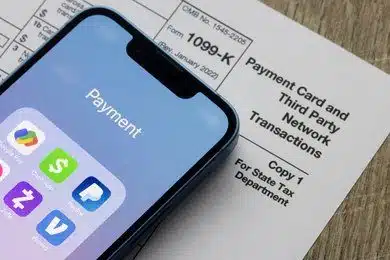How to Handle a 1099-K Selling Personal Items: A Guide
In today’s digital economy, getting a 1099-K selling personal items online has become a common practice for many, including gig workers, freelancers, and hobby sellers. However, the tax implications that come with these transactions are not as straightforward as one might think, especially when it involves receiving a 1099-K form.
Understanding how to handle a 1099-K selling personal items is crucial for taxpayers looking to comply with IRS regulations and avoid potential penalties. This article is a comprehensive guide to navigating the complexities of reporting income from selling personal items as a sole proprietorship. It ensures you are well-equipped to handle your tax obligations as a sole proprietor accurately and efficiently.
Understanding Form 1099-K and Its Purpose
Form 1099-K is a tax document issued to individuals and entities that receive payments through payment cards like credit and debit cards, or through third-party settlement organizations (TPSOs) such as payment apps and online marketplaces. This form is crucial for reporting transactions to the IRS and ensuring tax compliance.
Definition of Form 1099-K
Form 1099-K reports the gross amount of all reportable payment transactions and is sent to the IRS and the payment recipient. This form is necessary for tracking payments received via modern payment methods, which can include anything from online sales to freelance services provided through digital platforms.
Who needs to handle Form 1099-K?
Individuals or groups that get hold of payments through charge cards or third-party networks should cope with Form 1099-K. This includes folks who promote items or services and get hold of payments immediately through credit or financial institutions, playing cards, or online platforms, such as freelancers and gig workers who use platforms like PayPal. It is important for those recipients to apply this form alongside other statistics to appropriately document taxable income on their tax returns, especially if they receive payments through a payment processor or payment settlement entity.
Recent changes to Form 1099-K reporting thresholds
Recently, the threshold for reporting payments on Form 1099-K changed from situation to change. For the tax year 2023, the brink stays at $20,000 in costs and over two hundred transactions for personal or business accounts. However, the American Rescue Plan Act of 2021 reduced this threshold to $600 for business accounts. The IRS has not been on time for this variation, permitting extra time for implementation. This means that for 2023, the $20,000 threshold is maintained for personal accounts, but businesses may also problem the shape for totals over $600 to align with future necessities. If you receive a 1099-K, it would be in your best interest to report it.
Reporting Personal Items Sold at a Loss
When selling personal items at a loss, it’s important to understand how to document those transactions to keep away from misstating income. Here’s the way to navigate this process:
Determining if your sale qualifies for reporting
Personal items sold for less than their original purchase price (basis) should report no capital gain. For example, if a couch is first bought for $2,000 and then bought for $500, it will result in no deductible loss. However, profits from items offered above their basis, like jewelry bought for $300 and sold for $400, or household items such as appliances or clothing, should be reported.
How to accurately report a loss on personal items
Be careful when reporting losses on personal items because they’re not deductible. Ensure accuracy by reporting each item separately. Make sure gains don’t accidentally mix with losses, which could result in incorrect income reporting. For example, if you sell a mix of personal items with different gains and losses, be sure to itemize them individually on tax forms to accurately calculate the overall financial impact. Additionally, be sure to zero out the reported gross income for any personal items sold at a loss so you don’t pay taxes on them. This can be done by reporting the loss on your tax forms for personal property.
Using Schedule 1 and Form 8949 for reporting losses
For items sold at a loss, use Schedule 1 (Form 1040) to record and 0 out the Form 1099-K gross payment amount. If you promote a vehicle online for $21,000, which is less than what you paid for it, document this quantity as “Other Income” and offset it in “Other Adjustments” to neutralize the impact on your adjusted gross income. Alternatively, report losses on Form 8949, which carries over to Schedule D, ensuring your tax calculations reflect no net effect on your adjusted gross income. This process is especially important when handling the sale of your car, as it can affect your tax liability and reporting requirements for AGI.
Handling Sales of Personal Items at a Loss
When coping with sales of personal items at a loss, it’s important to apprehend that these losses are commonly nondeductible. The IRS does not allow people to say deductions for losses incurred from the sale of personal-use property. However, correct reporting is crucial to ensure compliance with tax regulations and not get audited.
Why Losses on Personal Item Sales are Nondeductible
Losses on personal items are nondeductible because they’re considered non-public charges. The IRS handiest allows deductions for losses related to enterprise or funding activities. This difference prevents the tax device from being used to subsidize private prices.
Strategies for Reporting Sales at a Loss to the IRS
To report a sale of personal items at a loss correctly:
- Report the Proceeds: Include the gross payment amount from Form 1099-K on Schedule 1 of Form 1040.
- Offset with Costs: Report your costs, ensuring they do not exceed the proceeds, on the same form to balance out the income, resulting in no net gain.
Documentation and Recordkeeping Best Practices
Maintaining thorough records is essential. Keep all relevant assisting files, such as sales slips, invoices, and receipts. These documents must detail the date of purchase, the amount paid, and the income charge to confirm your suggested amounts. Good recordkeeping not only supports your filings but also simplifies the method of reporting to the IRS.
Handling Profit from the Sale of Personal Items
When dealing with profits from the sale of personal items, it’s essential to decide if the sale resulted in taxable profit and document any profits appropriately.
Identifying if your sale resulted in taxable profit
Selling personal items for more than their basis, typically the original purchase price, results in a taxable gain. For example, selling a piece of jewelry bought for $300 at $400 results in a $100 gain. Report those profits on line 7 of the Federal 1040 tax go back. For example, if you promote a couch, jewelry, and a chair together for $1,000 with a basis of $2,400, you would report a $100 lengthy-term capital gain on Schedule D. However, it is important to note that not all sales of personal items result in taxable profit. It is crucial to properly identify if your sale of a personal item falls under the category of taxable gain, and if so, report it accordingly on your tax return.
Steps to document profits using Form 8949 and Schedule D
To report gains from the sale of personal items:
- Use Form 8949 to detail each sale transaction, the sale proceeds and the price basis.
- Mark the form with an “L” in column (f) to indicate a nondeductible loss, if relevant, and adjust the gain or loss to $0 in column (h).
- Summarize the transactions from Form 8949 on Schedule D of the Federal 1040 tax return, where the overall advantage or loss could be calculated.
It is important to keep detailed records of the income and costs of the items sold. This documentation will support the figures entered on the tax forms and ensure compliance with IRS requirements.
Common Mistakes to Avoid When Reporting
When reporting a 1099-K for selling personal items, avoiding unusual mistakes is essential to ensure correct reporting and compliance with tax policies. Here are a few key errors to watch out for:
Incorrect Reporting of Personal Use Items
When reporting on Form 1099-K, it is crucial to distinguish between commercial enterprise and private transactions. Personal gadgets bought at a loss have to no longer be said for tax functions, and peer-to-peer payments, including shared fees or gifts, are not considered taxable transactions. Misreporting these as net income can lead to inaccuracies on your tax return, as the Form 1099-K only shows your gross receipts and does not consider your cost basis and any adjustments for fees, refunds, credits, etc. Make sure to use your Form 1099-K as an informational document and compare it to your own records when filing your tax return to ensure accuracy. Good bookkeeping is key in avoiding any incorrect reporting of personal use items.
Failing to Report All Transactions
Taxpayers often make the mistake of not reporting all transactions. It is especially when the payments do not meet the threshold that triggers platforms’ automatic reporting. Remember to report all income accurately, regardless of amount or source, to avoid potential penalties.
Mixing Personal and Business Transactions
Separating personal and business finances is essential. Using a single account for both can complicate tax filings and lead to errors in reporting. Establish separate bank and credit accounts for business transactions to ensure clear and compliant financial records.
Misunderstanding the Tax Implications
Understanding the tax implications of Form 1099-K transactions is critical. Taxpayers should review their records to determine their taxable income accurately. Incorrectly reported amounts or misunderstandings of tax obligations can trigger audits or result in unnecessary tax liabilities.
FAQs
When are you required to report income from selling personal items on a 1099-K form?
You are required to report income from selling personal items on a 1099-K form anytime you receive a 1099-K form. This information is reported to the IRS by payment processors, providing transparency for tax purposes.
How does the IRS track and verify income reported on the 1099-K for selling personal items?
The IRS tracks and verifies income reported on the 1099-K by matching the reported amounts with payment card and third-party network transactions. They ensure that personal items sales are accurately reported for tax purposes, providing a clear record of income generated through such transactions.
Conclusion
Dealing with the tax rules for selling personal items and Form 1099-K can be tricky, but this guide helps you understand them clearly. It highlights the importance of knowing the tax effects of profits and losses, keeping good records, and understanding IRS rules. Knowing these details helps you avoid mistakes and stay compliant, preventing penalties. For more help with 1099-K issues, consider extra resources or consulting a tax professional. APC1040.com provides detailed advice and support. By following this guide and seeking help if needed, you can handle the sale of personal items confidently, understand their tax impact, and ensure a smooth, stress-free tax filing process.





